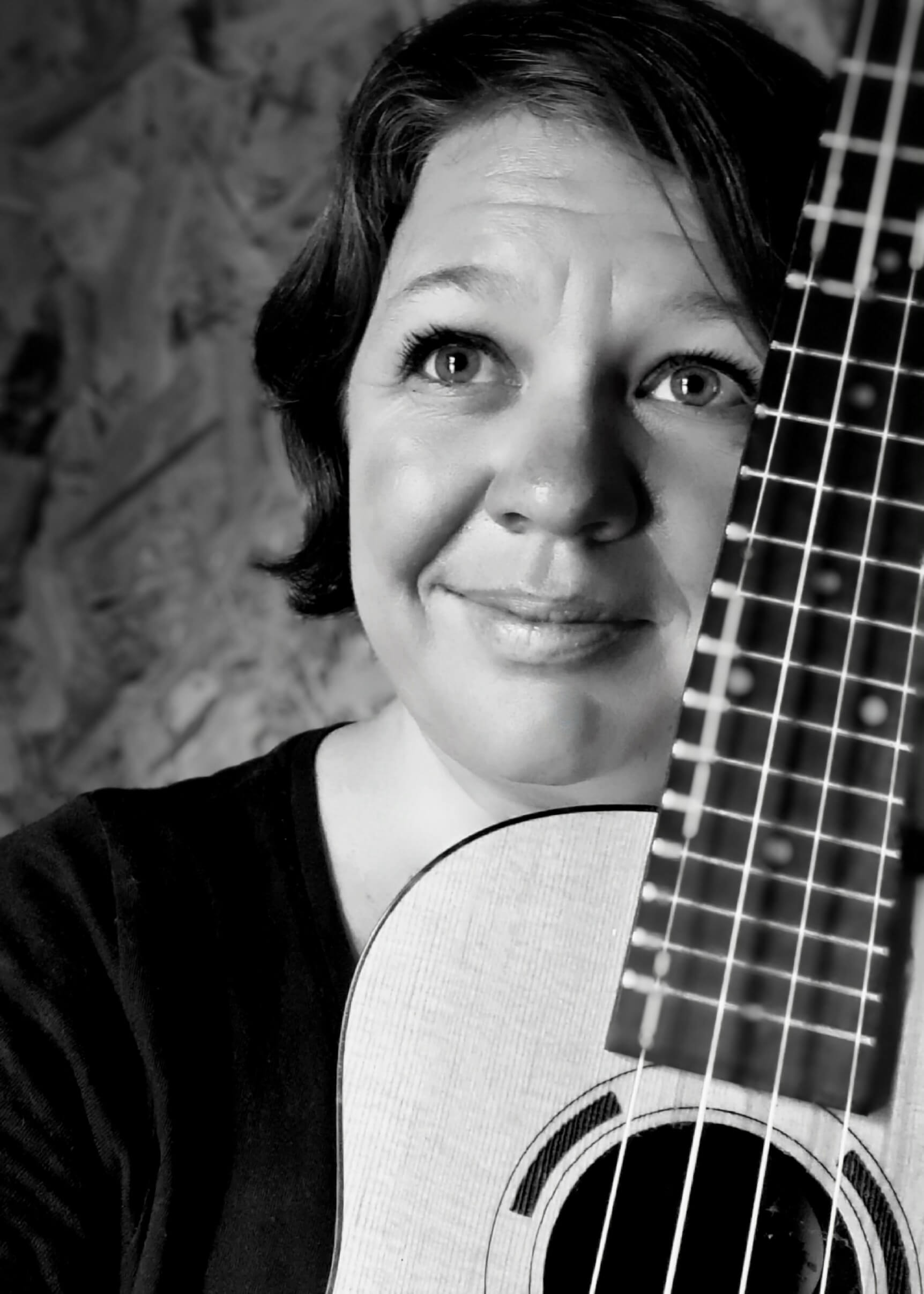Have you ever watched in amazement as musicians seemingly pluck melodies out of thin air, or effortlessly play along with songs they've never heard before? Chances are, they've honed their skills through functional ear training. In this comprehensive guide, we'll explore the world of functional ear training, what it is, why it's crucial for musicians, and how you can develop this essential skill.
What is Functional Ear Training?
Functional ear training is a method of developing stronger relative pitch skills by learning to hear the relationships between notes within a musical context. Unlike traditional ear training, which focuses on identifying intervals or chords in isolation, functional ear training emphasises understanding how notes function within a given key or tonal centre.
Think of it this way: if traditional ear training is like learning individual words in a language, functional ear training is about understanding grammar and context. It's not just about recognising a perfect fifth; it's about hearing how the fifth scale degree (sol) wants to resolve to the first (do) in a melody.
Why is Functional Ear Training Important?
There are many benefits to be gained from functional ear training:
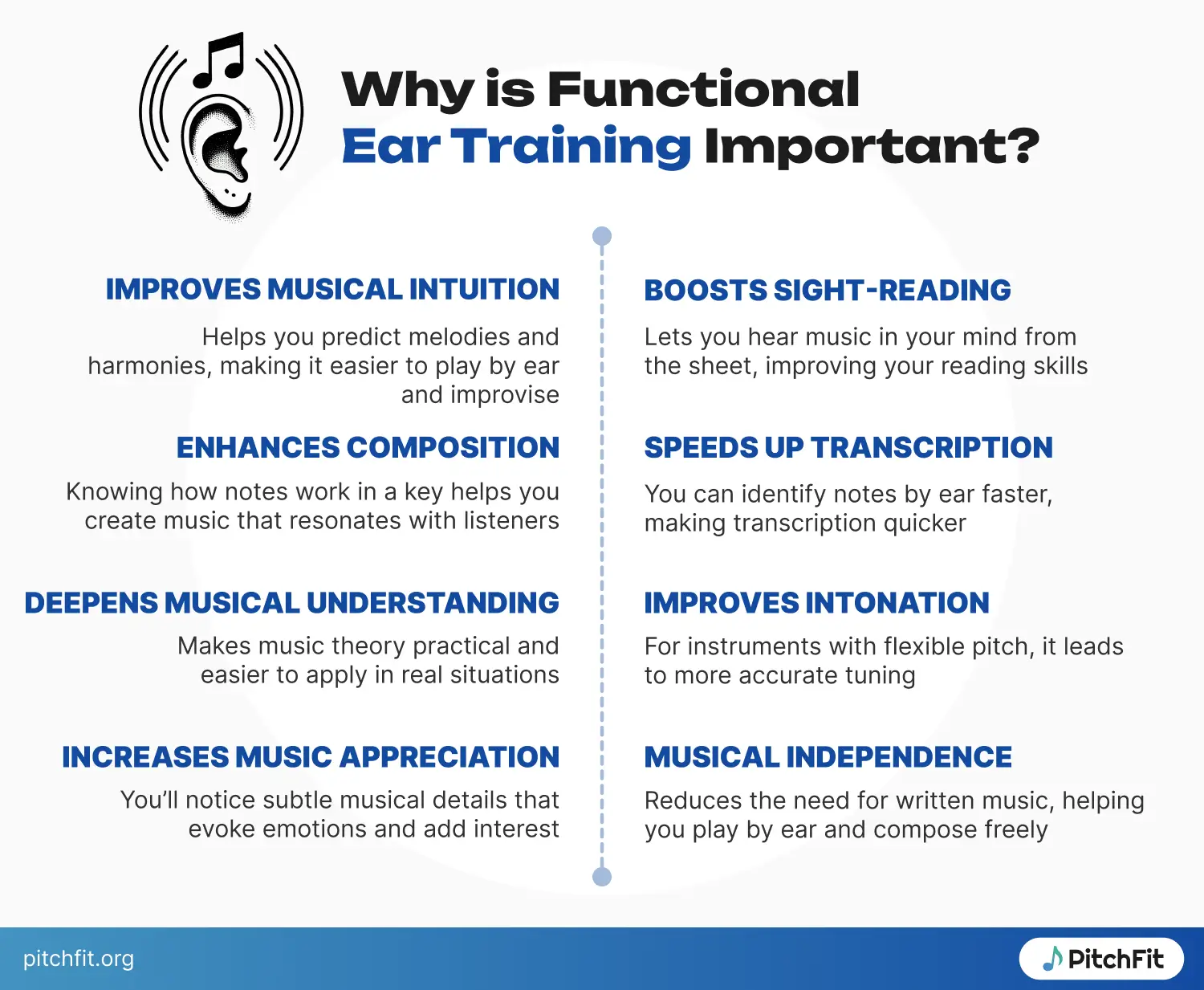
- Improved Musical Intuition: As you develop your functional hearing, you'll start to predict melodies and harmonies naturally, enhancing your ability to play by ear and improvise.
- Better Sight-Reading: When you can audiate (hear in your mind) how a piece should sound purely from its notation, your sight-reading skills will improve dramatically. It makes reading music similar to reading language.
- Enhanced Composition Skills: Understanding how notes function within a key will help you make more intentional and effective compositional choices. You’ll know how certain intervals and chords will affect the listener.
- Faster Transcription: You'll be able to transcribe music more quickly and accurately when you can easily identify scale degrees by ear.
- Deeper Musical Understanding: Functional ear training helps you internalise music theory concepts, making them practical rather than just theoretical.
- Better Intonation: For instruments with flexible pitch (like voice or fretless string instruments), understanding the function of each note can lead to more accurate intonation.
- Deeper Appreciation of Music: You'll listen to music with new ears, appreciating the subtleties of how composers and performers use different scale degrees to create emotion and interest.
- Musical Independence: With strong, functional hearing, you'll be less reliant on written music and better able to play by ear, improvise, and compose.
The Foundations of Functional Ear Training
Understanding Scale Degrees
The core of functional ear training is recognising scale degrees. In the major scale (the Ionian mode), we have seven distinct scale degrees, each with its own character:
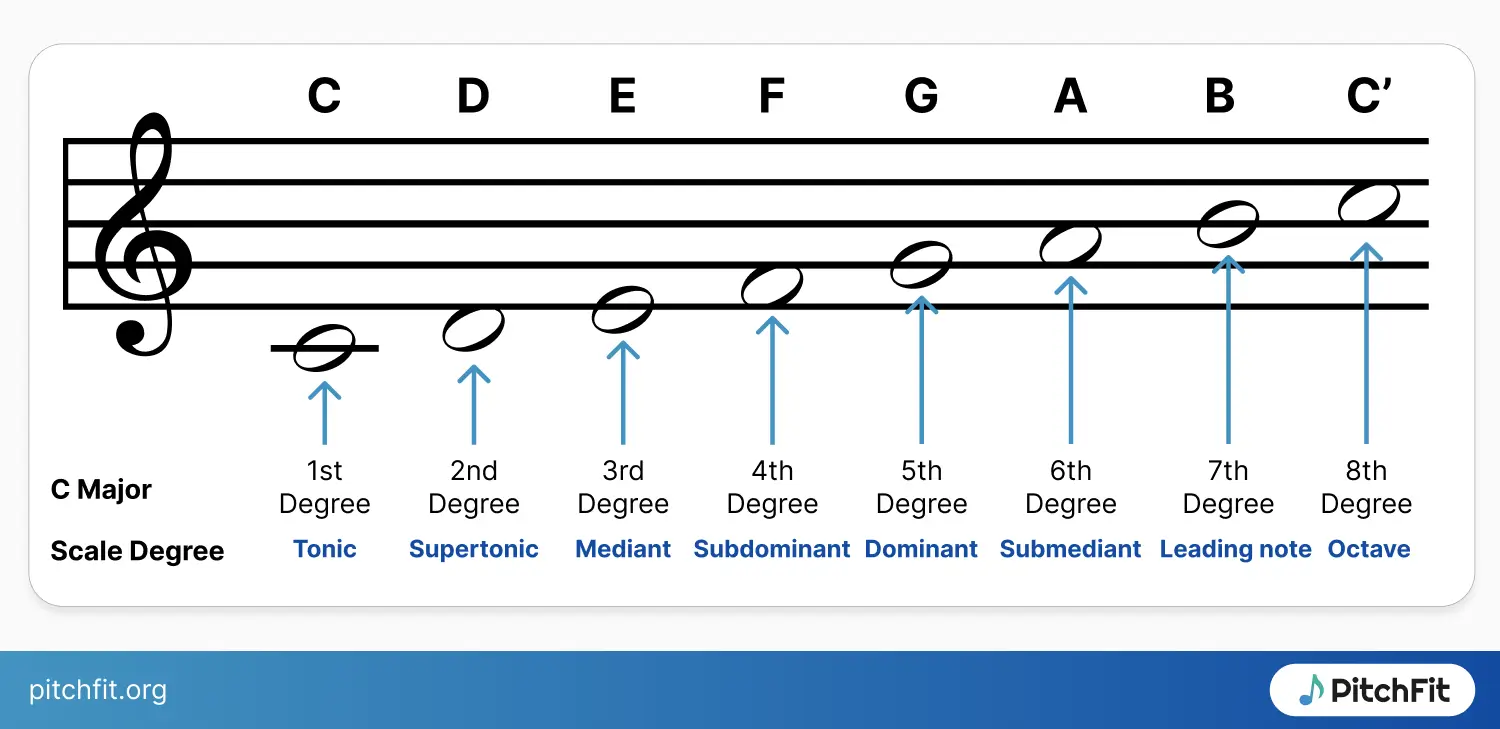
- Tonic (do): The home note, providing a sense of resolution.
- Supertonic (re): Often creates tension, typically wanting to resolve down to the tonic, up to the mediant, or even the dominant.
- Mediant (mi): Defines the tonality (major or minor) and plays a key role in defining chord qualities.
- Subdominant (fa): Creates movement away from the tonic, often leading to the dominant.
- Dominant (sol): Builds strong tension, naturally resolving to the tonic.
- Submediant (la): Often used in deceptive cadences or to start minor phrases. It can also be used to move to the subdominant.
- Leading Tone (ti): Has the strongest pull towards the tonic.
Each of these scale degrees has a unique "flavour" or feeling within the context of the key. Learning to recognise these flavours is at the heart of functional ear training.
The Role of the Tonic
In functional ear training, everything revolves around the tonic. It's your home base, your point of reference. All other notes are heard and understood in relation to the tonic. This is why it's called "functional" – we're training our ears to hear the function of each note.
Practical Strategies for Functional Ear Training
Now that we understand the basics, let's look at some practical strategies to develop your functional hearing:
1. Sing Your Scales
Start by singing major scales using solfege (do, re, mi, etc.). This helps connect the sound of each scale degree to a specific syllable, making it easier to remember them and recognise them in context.
Don't just sing up and down the scale. Practice jumping between different scale degrees, always returning to the tonic (e.g., do, mi, re, mi, mi, do, re, do)
2. Use a Reference Tone
Play a tonic note on an instrument, then try to sing different scale degrees. Start with easier ones like the fifth (sol) and third (mi), then progress to more challenging ones like the sixth (la) or seventh (ti).
3. Practice with Familiar Melodies
Take simple, well-known melodies and analyze them in terms of scale degrees. For example, "Happy Birthday" starts with "sol-sol-la-sol-do-ti". Once you've analyzed a melody, practice singing it with scale degree numbers or solfege syllables.
4. Ear Training Apps and Software
Utilise technology to support your practice. Apps like "Functional Ear Trainer" or "EarMaster" offer exercises specifically designed for functional ear training. These can provide structured practice and immediate feedback.
5. Transcription Exercises
Start transcribing simple melodies by ear, focusing on identifying the scale degrees rather than absolute pitches. As you improve, challenge yourself with more complex melodies and harmonies.
6. Harmonic Context Training
Practice identifying particular scale degrees within chord progressions. For example, can you pick out the third of a IV chord (which is the 6th scale degree of the overall key)?
7. Improvisation
Once you start developing your functional hearing, try improvising melodies over simple chord progressions. Focus on targeting specific scale degrees and hearing how they function over each chord.
Advanced Functional Ear Training Concepts
As you progress in your functional ear training journey, you'll find there are further levels of complexity to explore. These advanced concepts will challenge your ears and expand your musical understanding in exciting new ways. Let's dive into the deep end!
Modal Ear Training: Beyond Major and Minor
So, you've mastered the major scale? Great! Now it's time to explore the colourful world of modes. Modal ear training applies the principles of functional hearing to different modal contexts. It's like learning to speak the same language with different dialects.
Each mode has its own unique flavour, created by the relationship between its scale degrees and the tonic. For example:
- Dorian Mode: This minor-sounding mode has a raised 6th scale degree compared to the natural minor. Can you hear how this brightens the sound? Try singing a melody using only the notes of D Dorian (all the white keys from D to D on a piano) over a D minor chord. Notice how the B natural (the 6th degree) creates a distinctive sound, often giving the music a folky, or medieval flavour.
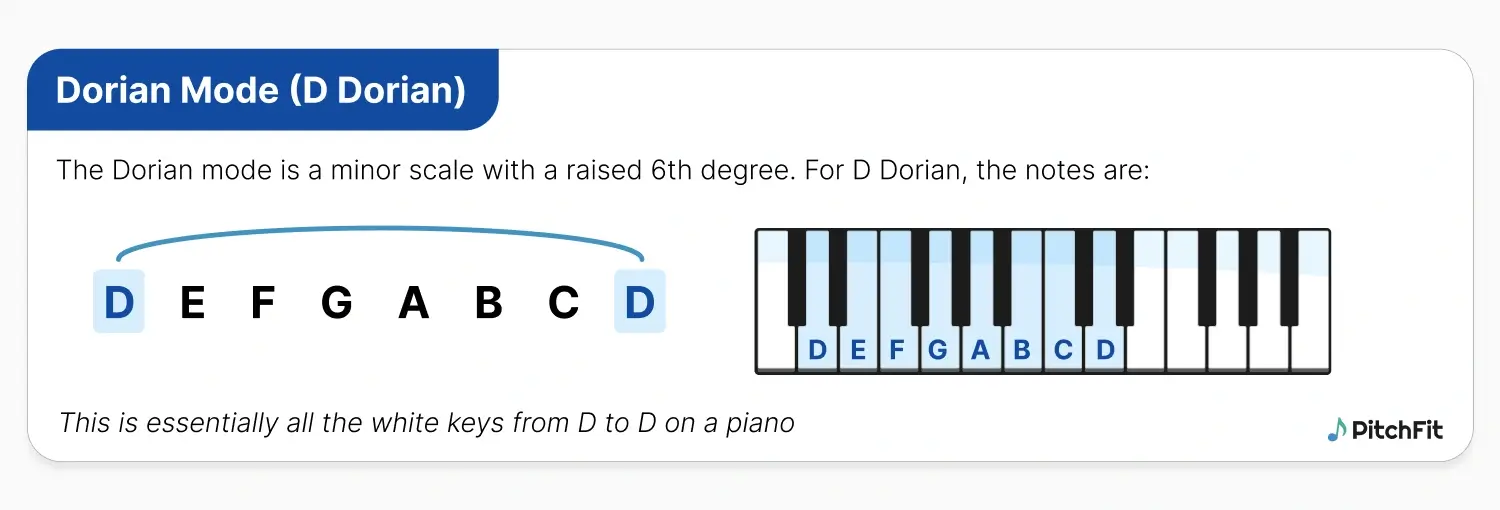
The Dorian mode is a minor scale that features a raised 6th note / Illustration by © PitchFit - Mixolydian Mode: A major scale with a lowered 7th, this mode is common in blues and rock. The lowered 7th reduces the strong pull back to the tonic that we're used to in the major scale. Play a G Mixolydian scale (G A B C D E F G) over a G7 chord and feel how the F natural (flowered 7th) changes the character of the scale.
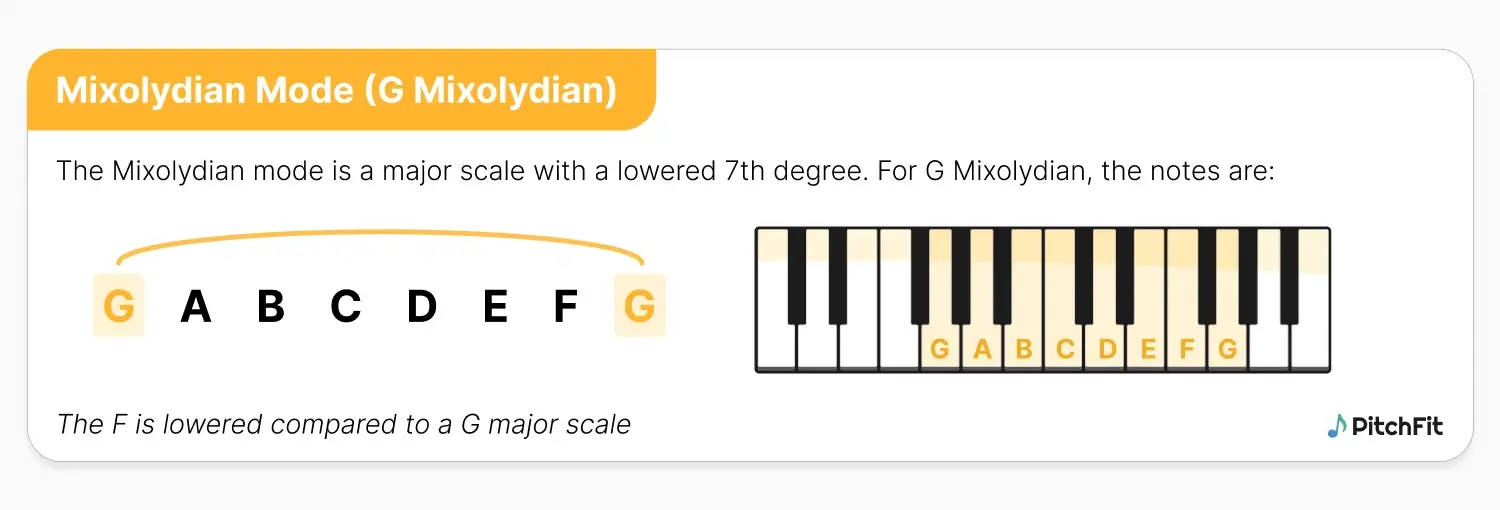
The Mixolydian mode is a major scale that has a lowered 7th note / Illustration by © PitchFit - Phrygian Mode: With its lowered 2nd, 3rd, 6th, and 7th scale degrees (compared to the major scale), Phrygian has a distinctly dark and exotic sound. The half-step between the 1st and 2nd degrees is particularly characteristic. Try singing an E Phrygian scale (E F G A B C D E) and notice the unique tension created by that low F right next to the tonic E.
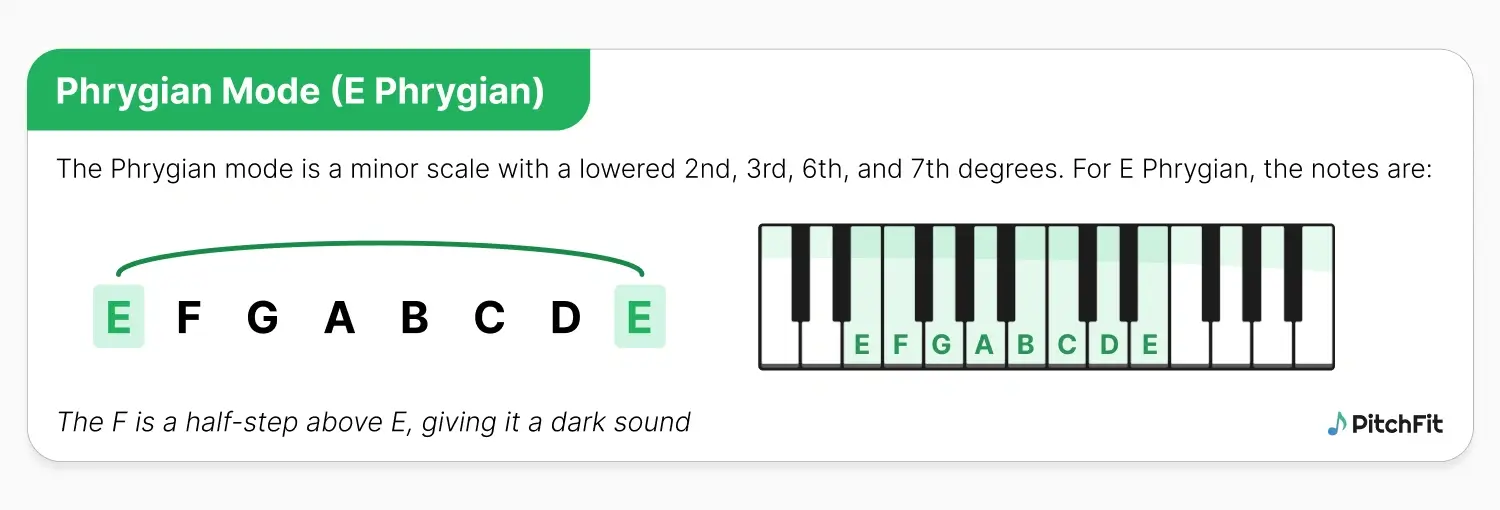
The Phrygian mode is a minor scale with lowered 2nd, 3rd, 6th, and 7th notes / Illustration by © PitchFit
Take a familiar melody and try singing it in different modes. How does "Happy Birthday" sound in Dorian or Phrygian? This exercise will help you internalise the unique character of each mode.
Chromatic Alterations: Adding Spice to Your Hearing
Chromatic alterations are like the secret ingredients in a chef's signature dish–they add that extra something special to the harmonic flavour. Training your ear to recognise these altered scale degrees will open up a whole new world of harmonic possibilities.
Let's explore a few common chromatic alterations:
- Lowered 7th (Subtonic) vs. Raised 7th (Leading Tone): In a major key, we're accustomed to hearing the raised 7th as a leading tone, pulling strongly towards the tonic. But what happens when we lower it? Suddenly, that strong pull disappears, replaced by a more relaxed, bluesy feel. Think of the difference between B natural and B flat in the key of C. The B natural (raised 7th) urgently wants to resolve to C, while the B flat (lowered 7th) is content to hang out, adding a cool, laid-back vibe. It’s a nice way to add a Mixolydian flavour to a major key.
- Raised 4th (Lydian ♯4): Adding a sharp to the 4th degree of a major scale gives us the distinctive sound of the Lydian mode. This raised 4th creates a bright, slightly unsettled sound that's common in film scores and jazz (think of the iconic opening of The Simpsons). In C major, try playing an F♯ instead of an F natural and feel how it adds tension to the sound. It can also create a sinister (albeit somewhat cartoonish) sound to your music.
- Lowered 6th (Minor 6th/Minor 13th): This alteration can infuse a touch of melancholy into a major key. In the key of C, an A♭ (instead of A natural) can create a bittersweet sound, especially when used over a major chord (creating a major triad with a minor 13th).
Play a major scale, then alter one note at a time. Sing the altered scale, paying close attention to how each chromatic change affects the overall sound and your expectation of where the melody wants to go next.
Modulations: The Art of Changing Keys
Modulation is like taking a journey from one musical landscape to another. It's a powerful tool for adding interest and emotional depth to music. Training your ear to follow modulations will enhance your understanding of complex musical structures and help you navigate key changes in real-time performance situations.
Here are some common types of modulations to explore:
- Direct Modulation: This is the most straightforward type – the music simply jumps from one key to another. It's like changing the channel on a TV. Listen for this in pop songs that shift up a half-step for the final chorus. It can be jarring, and surprising.
- Pivot Chord Modulation: This smooth type of modulation uses a chord that's common to both the original and new keys as a pivot point. It’s a bit like a fork in the road, an opportunity to try a new direction. Many classical pieces use this technique for subtle key changes.
- Common Tone Modulation: This technique uses a note that's common to chords in both keys to smooth the transition. It's like having a friend introduce you to a new group – the common tone is your familiar friend in the new key. If you start hearing a particular note a lot, it could be a clue that one of these key changes is coming.
- Phrase Modulation: This occurs when a phrase ends in one key, and the next phrase starts in a new key. It's common in song forms where different sections are in different keys. It can help create a sense of connection between otherwise distinct sections.
Take a simple chord progression (like C-F-G-C) and try modulating to different keys. Start with closely related keys (like G or F) and then try more distant modulations. Sing the bass notes or roots of each chord to help your ear follow the key change.
Atonal Functional Hearing: Finding Order in Chaos
Even in music that doesn't have a traditional tonal centre (atonal music), our ears still seek to create relationships between notes. Atonal functional hearing is about developing the ability to hear these relationships in music that doesn't follow conventional tonal rules.
Here are some approaches to developing atonal functional hearing:
- Interval Recognition: In atonal music, the relationship between individual notes becomes crucial. Practice recognising intervals, both melodically and harmonically, outside of a tonal context.
- Set Theory: This analytical method, often used for atonal music, groups notes into sets. Train your ear to recognise common sets and their inversions.
- Pitch-Class Centers: Even without a tonic, atonal pieces often have pitch centres. Practice identifying which notes or sets of notes seem to have gravitational pull in a piece. Your ear may well naturally latch on to these, especially with experience.
- Contour: In the absence of traditional harmony, the shape or contour of a melody can become more important. Practice audiating and reproducing melodic contours in atonal contexts.
Listen to atonal works by composers like Schoenberg, Webern, or Berg. Try to sing along with individual lines, focusing on accurately reproducing the intervals. Don't worry about finding a tonal centre – instead, focus on the relationships between the notes themselves.
Remember, these advanced concepts build on the foundation of basic functional ear training. Don't rush into them before you're comfortable with the basics. But when you're ready, these advanced techniques will take your musical hearing and understanding to new heights. They're challenging, yes, but also incredibly rewarding. As you explore these concepts, you'll discover new depths in the music you love and new possibilities in the music you create. Happy listening, and enjoy your journey into the fascinating world of advanced functional ear training!
Overcoming Challenges in Functional Ear Training
Developing functional hearing is a journey, and like any journey, it comes with its challenges. Here are some common hurdles and how to overcome them:
- Pitch Matching Difficulties: Some people struggle with matching pitches accurately. If this is you, start with simple exercises focusing just on matching a single pitch. Gradually expand to distinguishing between two pitches, then three, and so on. It is a common early problem, but it is surpassable, don’t give up!
- Maintaining the Tonal Center: It's easy to lose sense of the tonic, especially in longer exercises. Regularly return to the tonic in your practice sessions to reinforce it. Some ear training apps play the tonic between each exercise, which can be helpful. Eventually, your inner ear will help you remember the tonic without the reminders.
- Confusion with Similar-Sounding Scale Degrees: Some scale degrees, like the 2nd and 7th, can sound similar at first. Focus on the unique character of each – the 2nd (re) has a more stable quality, while the 7th (ti) has a strong pull towards the tonic.
- Overwhelming from Too Many Options: Start with just two or three scale degrees and gradually add more as you become comfortable. Quality of recognition is more important than quantity at first. Don’t run before you can walk!
- Discouragement from Slow Progress: Remember, you're essentially learning a new way of hearing music. Be patient with yourself and celebrate small victories. Consistent practice, even for just 10-15 minutes a day, will yield results over time. You could try to aim for particular milestones or give yourself a test once a month to show yourself how you are progressing. It’s hard to see because it’s so slow, but by consistently practising, you will improve.
Integrating Functional Ear Training into Your Musical Life
Functional ear training isn't just about doing exercises – it's about changing how you interact with music in your daily life. Here are some ways to integrate your developing skills into other musical activities:
- Active Listening: When you listen to music for pleasure, try to identify the scale degrees in the melody or bass line. Start with simpler music and progress to more complex pieces as your skills improve. Later you can try and work out chord sequences, key changes and much more.
- Sing Along: Whether you're a vocalist or not, singing along with music using solfege or scale degree numbers can reinforce your functional hearing. It can reinforce musical memory.
- Composition: Use your growing understanding of how scale degrees function to inform your compositional choices. Experiment with creating melodies that target specific scale degrees for different emotional effects.
- Band Practice: If you play in an ensemble, try to communicate using scale degrees. Instead of saying "Play an A here," you might say "Land on the 5th degree of the key." Training yourself to think in these terms will make it easier to remember them.
- Teaching: If you teach music, incorporate functional ear training concepts into your lessons. It can provide students with a deeper understanding of music theory and improve their overall musicianship.
Conclusion: Your Functional Ear Training Journey
We’ve explored how functional ear training is a powerful tool that can transform your relationship with music. It's not the same as having "perfect pitch" or some innate, untrainable talent–it's a skill that anyone with patience and consistent practice can develop.
As you embark on this journey, remember that every expert was once a beginner. The key is to make functional ear training a regular part of your musical practice. Start small, be consistent, and don't be afraid to challenge yourself as you improve.
Whether you're a beginner just starting your musical journey or a seasoned professional looking to sharpen your skills, functional ear training has something to offer you. It's a pathway to greater musical fluency, creativity, and enjoyment.
So put on your favourite tunes, fire up that ear training app, or sit down at your instrument. Your ears are waiting to be opened to a whole new world of musical understanding. Here's to your functional ear training success!



